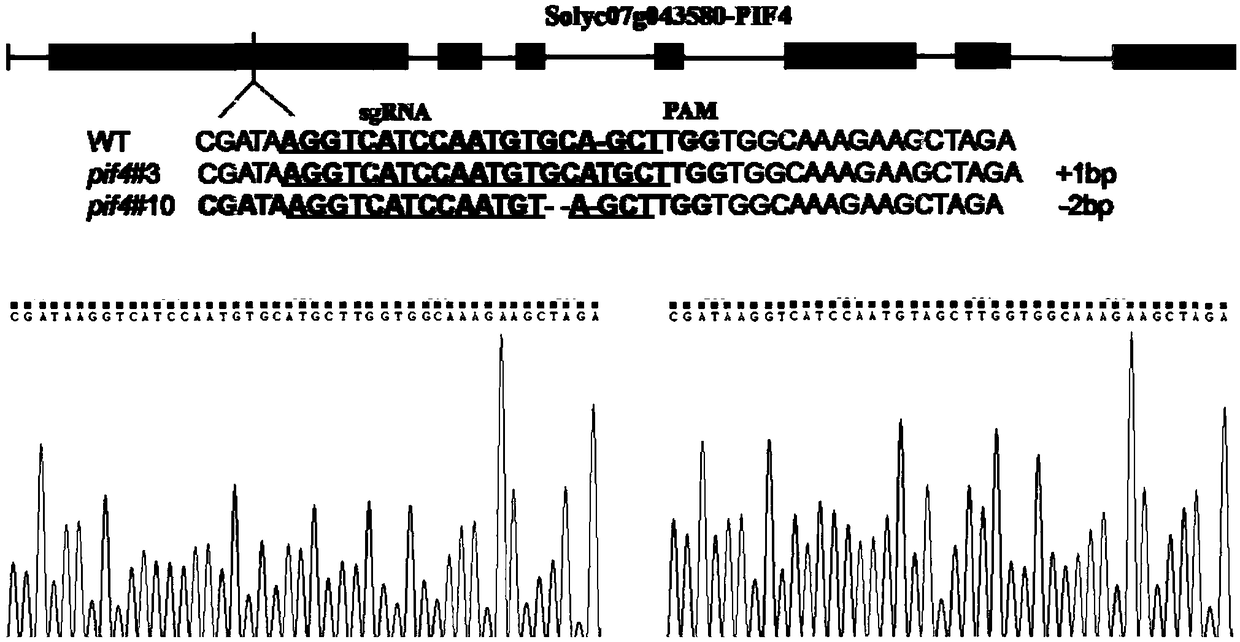Tomato Sl1PIF4 gene, protein and application thereof to improving low temperature resistance of plant
A gene, tomato technology, applied in the application of SlPIF4 gene in improving plant low temperature resistance, in the field of tomato transformation, to achieve the effect of enhancing low temperature resistance, good application value, and improving low temperature resistance
- Summary
- Abstract
- Description
- Claims
- Application Information
AI Technical Summary
Problems solved by technology
Method used
Image
Examples
Embodiment 1
[0041] Embodiment 1: Construction of SlPIF4 gene overexpression vector
[0042] To understand the molecular mechanism of plant response to low temperature, the SlPIF4 gene was cloned from the tomato genome. According to the sequence analysis of the coding region, design specific primers SlPIF4-F and SlPIF4-R, and respectively add restriction enzyme cutting sites (Asc I and Kpn I) on the primers, the sequences are shown in SEQ ID NO: 3 and 4 . The SlPIF4 fragment was amplified by PrimerSTAR high-fidelity enzyme PCR, and then the PCR amplified fragment and the vector were digested, and the SlPIF4 fragment was connected to pFGC1008-HA to obtain the overexpression vector OE. The above-mentioned recombinant plasmid was sent to Qingke Company for sequencing and confirmation. The nucleotide sequence of the obtained gene SlPIF4 is shown in SEQ ID No: 1; the amino acid sequence of the protein encoded by the gene is shown in SEQ ID No: 2. The results showed that the cloned sequence wa...
Embodiment 2
[0043] Embodiment 2: Construction of SlPIF4 gene mutation carrier
[0044] The SlPIF4 gene target sequence was designed using the CRISPR-P website, and the specific sequence is shown in SEQ ID No: 5, which is AGGTCATCCAATGTGCAGCT. The synthetic target sequence was annealed and ligated to the Bbs I site of the AtU6-sgRNA-AtUBQ-Cas9 vector, and then the newly obtained AtU6-sgRNA-AtUBQ-Cas9 fragment was ligated to the Hind III / Kpn I site of the pCAMBIA1301 vector. The above-mentioned recombinant plasmids were sent to Qingke Company for sequencing and confirmation.
Embodiment 3
[0045] Example 3: Construction and detection of tomato SlPIF4 transgenic material
[0046] The overexpression vector pFGC1008::SlPIF4-HA and the gene editing vector pCAMBIA1301::AtU6-sgRNA(SlPIF4)-AtUBQ-Cas9 were used. Transform Agrobacterium EHA105, and infect tomato cotyledon, through induction of callus, resistance-induced differentiation and rooting culture, to obtain tissue culture shoots, T2 generation mutant seeds and overexpression seeds were tested for kanamycin resistance and chlorine For the test of mycin resistance, 3 / 4 of the strains with resistance and the remaining 1 / 4 without resistance were selected, indicating that the overexpression vector with the target gene was inserted in a single copy form in this strain. These plants were removed and harvested individually. Using Western Blot to verify SlPIF4 overexpression positive transgenic plants, the results showed that the wild type had no protein band, while the overexpression line had a band of SlPIF4-HA ( fi...
PUM
 Login to View More
Login to View More Abstract
Description
Claims
Application Information
 Login to View More
Login to View More - R&D
- Intellectual Property
- Life Sciences
- Materials
- Tech Scout
- Unparalleled Data Quality
- Higher Quality Content
- 60% Fewer Hallucinations
Browse by: Latest US Patents, China's latest patents, Technical Efficacy Thesaurus, Application Domain, Technology Topic, Popular Technical Reports.
© 2025 PatSnap. All rights reserved.Legal|Privacy policy|Modern Slavery Act Transparency Statement|Sitemap|About US| Contact US: help@patsnap.com



